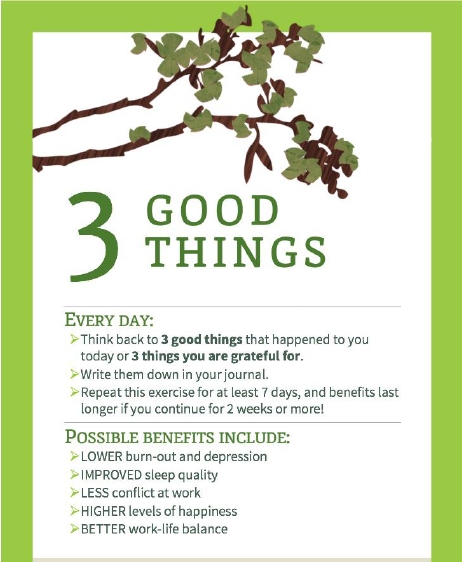 If everything you have to do in life is overwhelming you and making you depressed, there’s a simple technique that you can employ. This technique has the power to increase your happiness and decrease depression. It can also offer a sense of sanity when your life appears to be falling apart.
If everything you have to do in life is overwhelming you and making you depressed, there’s a simple technique that you can employ. This technique has the power to increase your happiness and decrease depression. It can also offer a sense of sanity when your life appears to be falling apart.
It’s called Three Good Things and was developed by Martin Seligman, professor of psychology at the University of Pennsylvania, and known as the father of positive psychology. He applied this technique to subjects in a research study in 2005, finding that using it had the same effect as Prozac in improving the subjects’ well being.
Basically at the end of the day you write down three good things that happened to you that day and reflect on those three things.
The reason why it works, according to Seligman, is that “it changes your focus from what goes wrong in your life to what goes well.” In his experiment Seligman showed that you can go from 15 on the happiness scale to 50, just from doing this exercise for a week. And even if you stop, the resulting improved attitude can last for weeks or even months.
According to J. Bryan Sexton, professor of psychology at Duke University, noticing the positive things short circuits our natural tendency to concentrate on the negative. We tend to focus on the negative as a sort of a biological survival method. When something bad happens that can endanger us, we want to remember it so it doesn’t happen again. Not so for the good things. They tend to get lost and forgotten.
One of the best things this exercise can do is improve your sleep. That’s why you should do it within two hours of bedtime, but the closer the better. Having positive thoughts about your day will help you sleep better and deeper, and if you wake up in the middle of the night, you will be able to go back to sleep faster and easier, according to Sexton.
Here’s how to do it:
Sit down with a notebook or just a pen and paper – or you could do it on the computer as well – and write down three good things that happened to you that day. You should give the event a title and write down as many details as possible. What happened, where it happened, how it made you feel, and most importantly, your role in making the good thing come about.
Here are a few examples:
I reached a hiring manager.
After calling 35 of the 50 companies on my list, I finally reached a hiring manager. I gave her my elevator pitch and asked if I could send her my resume. I was so happy after all of the negative replies I had received I finally had a conversation. She wanted my resume, which I also sent in.
I called an old friend.
I called an old friend who is working in a job similar to what I would like to do and invited him to meet me for coffee next week. It made me feel good, because I haven’t been calling many of my contacts lately, but I know that’s the way to network and ultimately find a job.
I chatted with my next door neighbor.
I saw my next door neighbor Rosa today and stopped to talk to her. She’s nearly 80, and I know she’s lonely, since she has no family nearby. I love to hear her stories, though, and talking to her always makes me happy.
Keep a Three Good Things journal for at least a week – two is better. Although it might be difficult at first, this exercise will train your mind to highlight the positive things that happen in your life. Remembering them might push some of the negative thoughts to the far corner of your brain.
It’s not only a good habit to develop, but you should be much happier as a result.
For other ways to increase your happiness and sense of well-being, check out:
How being kind can help you feel happier and healthier
Three simple tips to cultivate happiness

